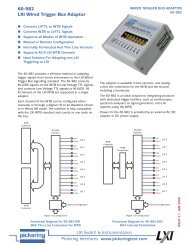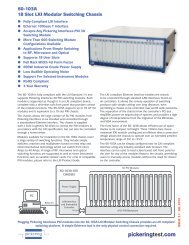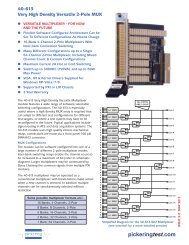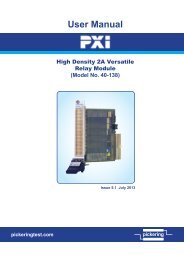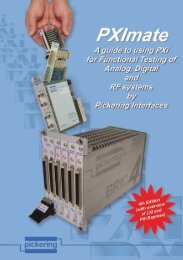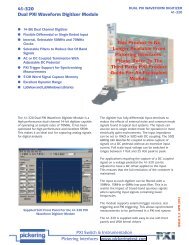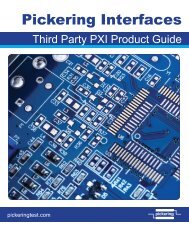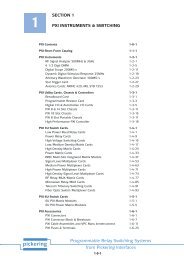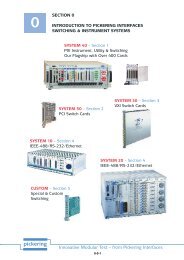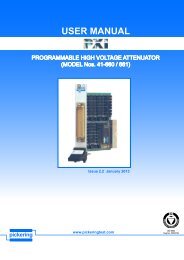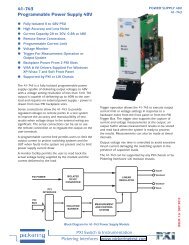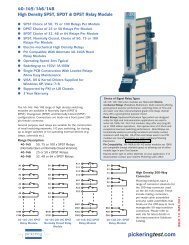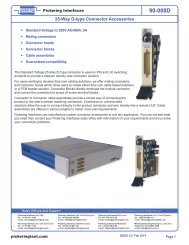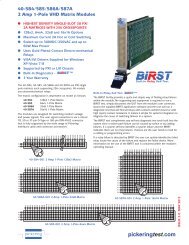40-535M.pdf - Pickering Interfaces
40-535M.pdf - Pickering Interfaces
40-535M.pdf - Pickering Interfaces
Create successful ePaper yourself
Turn your PDF publications into a flip-book with our unique Google optimized e-Paper software.
Section 4 - PROGRAMMING GUIDE<br />
pickering<br />
Register-level Programming<br />
Where the supplied drivers are not suitable, register-level programming can be employed - for example:<br />
●●<br />
●●<br />
●●<br />
●●<br />
If the functionality of the supplied drivers does not meet the application requirements<br />
If security considerations demand full source-code for the application<br />
In development environments that have alternate mechanisms for accessing PCI bus<br />
For operating systems other than Windows<br />
Programming for LXI<br />
When <strong>Pickering</strong> PXI cards are inserted into an LXI Modular Chassis a different set of drivers is available.<br />
IVI Driver for Windows - pi<strong>40</strong>iv<br />
The pi<strong>40</strong>iv IVI also supports LXI inserted cards simply by changing the resource string to address string to the<br />
appropriate address.<br />
Direct I/ODriver for Windows - Piplx<br />
The piplx driver is based on the PXI Direct IO driver pilpxi, but with added functionality to deal with the added need<br />
to address the chassis using an IP address. It integrates well with LabWindows/CVI and LabVIEW, and is fully<br />
compatible with Switch Executive. It is also usable in general-purpose programming environments such as Visual<br />
C++ and Visual Basic.<br />
Please note that this driver may also be used in the PXI domain. If the addressed card is in the local computer PCI/<br />
PXI system, commands will be passed through to the PXI Direct IO driver. This mechanism allows the piplx driver<br />
to be used for both PXI and LXI cards.<br />
The LXI format offers additional interface options not available in PXI :<br />
.NET<br />
A .NET native driver is also available. Once again this may be used for both LXI and PXI card control.<br />
SOAP<br />
<strong>Pickering</strong> LXI products include a SOAP interface which is usable from a wide variety of platforms and languages.<br />
SSH<br />
<strong>Pickering</strong> LXI products include an SSH interface which allows remote command line access to control cards, or,<br />
using a suitable package, programmatic control.<br />
The user is advised to visit the <strong>Pickering</strong> web site for further details of all the above drivers, where documentation,<br />
example programs, and further help with driver choice are available.<br />
LabVIEW, LabWindows/CVI and Switch Executive are trademarks of National Instruments Corporation.<br />
General <strong>Pickering</strong> Card Architecture<br />
With most drivers, before programming a <strong>Pickering</strong> card it is important to understand the basic architecture of<br />
<strong>Pickering</strong> cards.<br />
The switches on a <strong>Pickering</strong> card are organized into logical sub-units, each sub-unit containing a set of objects of<br />
similar type and use. These objects may be switches, digital outputs, digital inputs, resistors, power supplies etc,<br />
depending on the nature of the specific card.<br />
For example a simple matrix card will usually contain a single sub-unit containing the switches arranged in a<br />
2-dimensional array. However a similar card with additional isolating relays connected to the matrix will contain<br />
additional sub-units containing those isolation relays.<br />
Low level drivers include functions to allow the programmer to query the card to ascertain the number of sub-units,<br />
and the size and type of each sub-unit.<br />
For full details of the driver functions available the programmer should refer to the documentation provided.<br />
Page 4.2<br />
Ultra High Density MATRIX MODULE <strong>40</strong>-535/536/537



